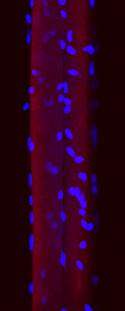Hormone replacement therapy improves muscle function

Hormone replacement therapy (HRT) significantly improves muscle function – down to the muscle fibre level – in postmenopausal women, a new study published today in The Journal of Physiology shows.
Some studies published over the last decade have led to negative publicity around HRT, a treatment used to relieve symptoms of menopause, resulting in many women being reluctant to use it. However this new study offers a positive outcome from the treatment.
Previous studies, monitoring walking speed and jumping height, have suggested that HRT reduces the impacts of age-related decline in muscle mass and strength. This new study is the first to explore these effects at cellular and molecular levels. The research team observed pairs of postmenopausal identical twins – of whom only one of each pair was receiving HRT – in order to rule out genetic differences, and then performed close examination of muscle biopsies taken from them.
Dr Lars Larsson, from Uppsala University Hospital Sweden, who led the study, said:
"We found that even though individual muscle fibres did not change in size, the muscles of HRT users showed greater strength by generating a higher maximum force compared to non-HRT users. It is thought that using HRT, at least in part, reduces modifications of muscle contractile proteins that are linked to ageing."

"HRT is also associated with a more efficient organisation of myonuclei, which are essential components for muscle fibre function. In HRT users, the different myonuclei arrangement optimises cellular level protein transport that leads to improved muscle function."
"Fall and fall-related injuries are common among elderly individuals, with significant socioeconomic consequences for individuals and society, and women are affected more than men due to the decrease in female sex hormone production."
"Future studies are focusing on the molecular mechanisms underlying the ageing-related changes in skeletal muscle and the specific effects of HRT on the structure and function of the dominant protein in skeletal muscle, called myosin, which generates force and movement."
These findings open up possibilities for future pharmacological interventions aimed at enhancing muscle mass and function in old age, and improving quality of life.
More information: Hormone replacement therapy improves contractile function and myonuclear organization of single muscle fibres from postmenopausal monozygotic female twin pairs. Rizwan Qaisar, Guillaume Renaud, Yvette Hedstrom, Eija Pöllänen, Paula Ronkainen, Jaakko Kaprio, Markku Alen, Sarianna Sipilä, Konstantin Artemenko, Jonas Bergquist, Vuokko Kovanen, and Lars Larsson. Journal of Physiology, May 1, 2013 591 (9) 2333-2344; doi:10.1113/jphysiol.2012.250092















